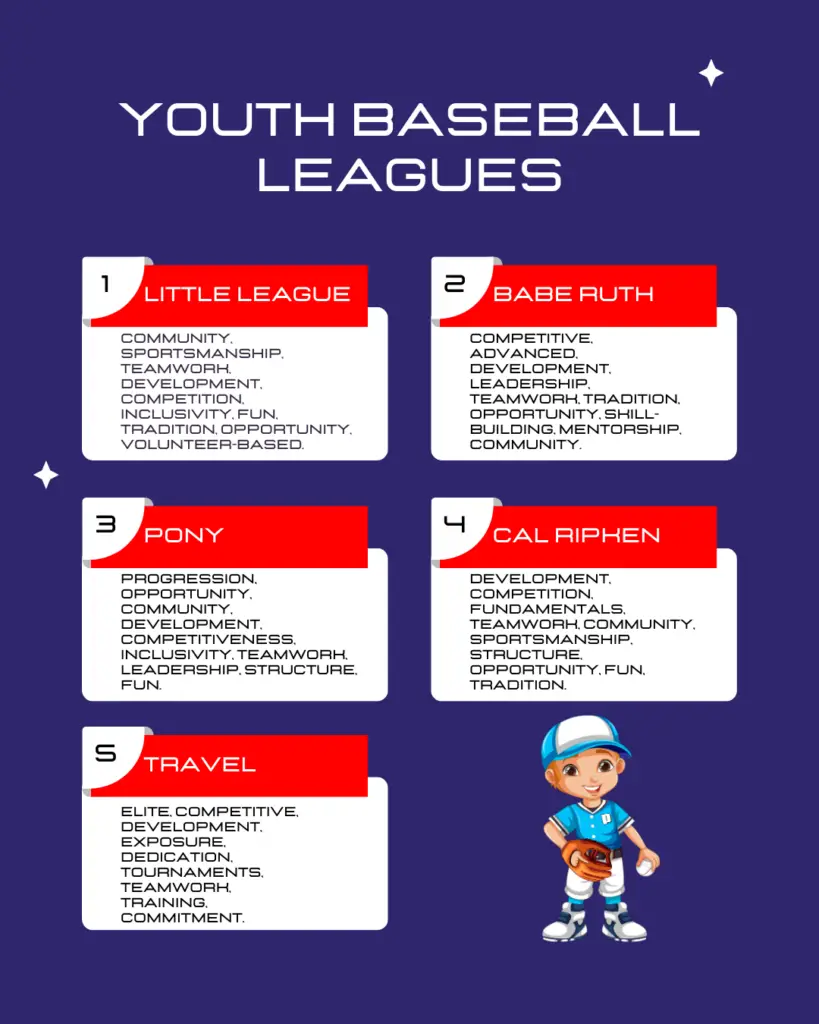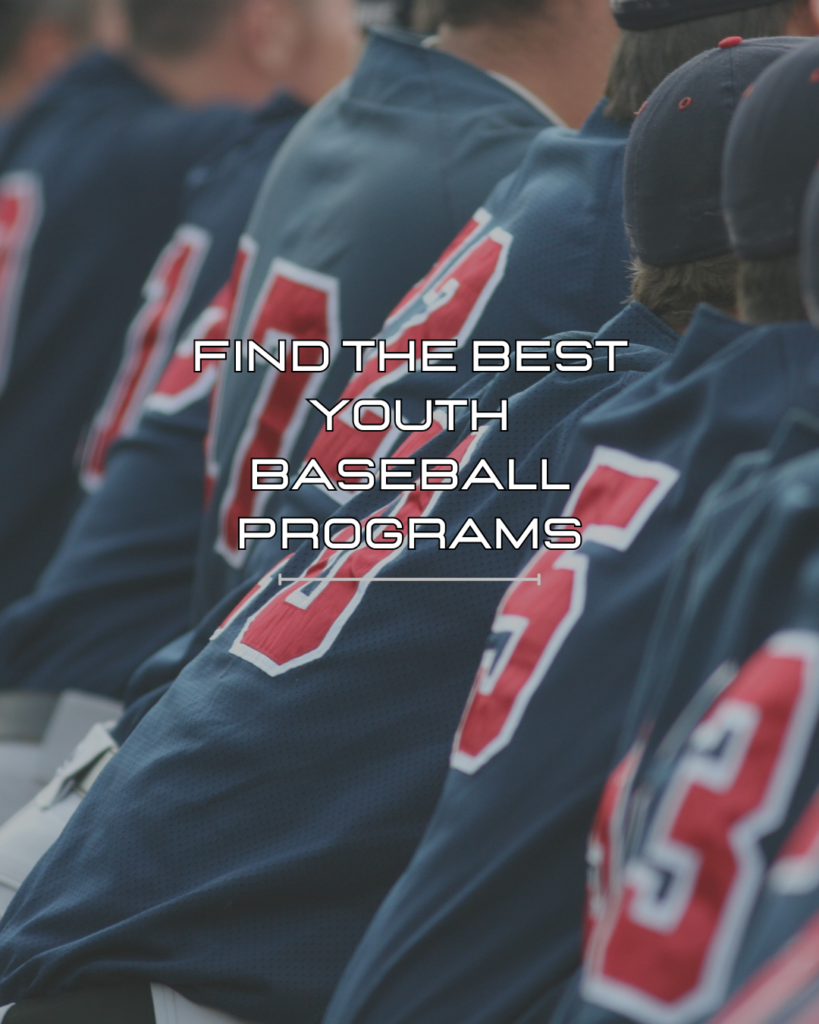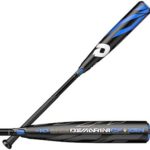Are you considering enrolling your child in one of the youth baseball leagues but feeling overwhelmed by all the different options available?
Fear not, we’re here to help you understand the different youth baseball leagues and find the one that is perfect for your child.
From Pony League to Little League to Cal Ripken Baseball, each league offers unique experiences and caters to different age groups and skill levels.
Understanding the differences between these leagues can ensure that your child has a positive and rewarding baseball experience.
In this article, we will break down the characteristics of popular youth baseball leagues, explaining the age groups they serve, the skill levels required, and the overall experience your child can expect.
Whether your child is just starting out or is a seasoned player, we will help you determine which league is the best fit.
By the end of this article, you will have a clear understanding of what each youth baseball league offers.
This will allow you to make an informed decision that will help your child develop their skills, cultivate a love for the game, and have a blast on the baseball field.
Let’s dive in!

Quick Links to Info on this Page:
What Are the Main Youth Baseball Leagues?
When exploring youth baseball opportunities, it’s essential to understand the various leagues available, each designed to cater to different age groups, skill levels, and developmental goals.
The most recognized leagues include Little League, Pony Baseball, Babe Ruth Baseball, and Cal Ripken Baseball.
Each league has its own set of rules, age divisions, and competitive structures, making it crucial for parents to familiarize themselves with these differences as they make decisions about their child’s participation.
Little League is perhaps the most well-known youth baseball organization, founded in 1939.
It has grown significantly over the decades, now offering programs for children aged 4 to 16.
The structure of Little League includes various divisions based on age and skill level, allowing players to develop in a supportive environment.
The league also emphasizes sportsmanship, teamwork, and community involvement, providing a foundation for young athletes both on and off the field.
Pony Baseball, established in 1951, offers another competitive alternative for youth players, typically ranging from ages 4 to 14.
The league’s unique aspect lies in its flexible age divisions, which allow for more tailored competition among players of similar skill levels.
Pony Baseball also focuses on player development, ensuring that young athletes receive proper coaching and guidance as they progress through their baseball journey.
Understanding the fundamental differences between these leagues will aid parents in selecting the right fit for their child.
Little League vs. Pony Baseball – Key Differences
While both Little League and Pony Baseball are popular choices for youth players, they differ significantly in structure, rules, and overall philosophy.
One of the most notable distinctions is the age divisions and eligibility requirements. Little League has a more rigid age classification system, grouping players into divisions based on their exact ages, which can sometimes lead to mismatches in skill levels.
Conversely, Pony Baseball offers a more flexible approach, allowing players to compete in divisions that suit their specific abilities and experience levels.
Another key difference lies in the field dimensions and gameplay rules.
Little League utilizes smaller field dimensions, which can be beneficial for younger players who are still developing their skills and confidence.
This smaller scale can help new players feel more comfortable, allowing them to focus on learning the fundamentals of the game.
On the other hand, Pony Baseball plays on larger fields, which can provide a more authentic baseball experience and better prepare players for higher levels of competition as they grow older.
Furthermore, the competitive nature of each league can vary.
Little League is often seen as more community-oriented, emphasizing participation and fun over competition.
In contrast, Pony Baseball tends to have a slightly more competitive focus, encouraging players to strive for excellence while still nurturing their love for the game.
As parents evaluate their options, considering the values and experiences each league promotes will be essential in making the right choice for their child.

Babe Ruth vs. Little League – Which One is Better for Your Child?
When comparing Babe Ruth Baseball and Little League, it’s essential to consider the age ranges, competitive structure, and overall experience each league offers.
Babe Ruth Baseball typically serves older youth players, usually ranging from ages 13 to 18.
This league provides a transitional bridge for players moving from youth baseball into high school and even collegiate levels.
As such, it places a strong emphasis on skill development and competition, making it an appealing option for those who are serious about pursuing baseball at higher levels.
Little League, on the other hand, caters to a broader age range, from 4 to 16 years old.
While it does have competitive divisions, it also emphasizes inclusivity, encouraging players of all skill levels to participate and enjoy the game.
This focus on participation can be particularly beneficial for younger players who are still discovering their passion for baseball and may not yet be ready for the heightened competition found in Babe Ruth leagues.
Another factor to consider is the level of commitment required by each league.
Babe Ruth Baseball often demands a greater time commitment due to its competitive nature and the potential for travel to games and tournaments.
Parents should assess their child’s readiness for this level of involvement before making a decision.
Conversely, Little League may offer a more manageable schedule, which can be appealing for families seeking a balance between sports and other commitments.
Ultimately, the choice between Babe Ruth and Little League will depend on the player’s age, skill level, and family priorities.
What is Cal Ripken Baseball?
Cal Ripken Baseball, named after the legendary Baltimore Orioles player, is another prominent youth baseball organization that caters primarily to children aged 4 to 12.
This league is designed to provide a fun, engaging environment for young athletes while emphasizing skill development and sportsmanship.
One of the unique features of Cal Ripken Baseball is its commitment to using age-appropriate rules and field dimensions, which ensures that players can enjoy the game while developing their abilities in a supportive setting.
The league is structured around a tiered system, allowing players to advance based on their skills and experience.
This progression helps maintain a competitive balance, ensuring that players are challenged while still being able to enjoy the game’s various aspects.
Additionally, Cal Ripken Baseball places a strong emphasis on teaching fundamental skills and strategies, allowing young athletes to grow as players and teammates.
Another significant aspect of Cal Ripken Baseball is its focus on community involvement and family engagement.
The league encourages parents to get involved, whether through coaching, volunteering, or simply cheering on their children.
This collaborative environment fosters a sense of belonging and camaraderie among players and families, making it a great option for those seeking a positive and enriching baseball experience for their child.

What is Travel Baseball?
So what is travel baseball anyway?
Travel baseball offers a competitive alternative to traditional youth leagues for families seeking a more intense baseball experience.
Typically designed for players aged 8 to 18, travel baseball teams often compete in tournaments and games against teams from outside their local area.
This format allows players to face a higher level of competition, providing opportunities for skill development and exposure to different playing styles.
However, it is essential for parents to understand the commitment and costs associated with travel baseball before enrolling their child.
One of the most significant differences between travel baseball and recreational leagues is the level of commitment required.
Travel teams often have rigorous practice schedules, frequent games, and travel obligations that can take up considerable time.
This commitment can be rewarding for dedicated players who aspire to play at higher levels, such as high school or college baseball.
However, it may not be the right fit for every child, particularly those who are just starting or prefer a more casual approach to the sport.
Additionally, the costs associated with travel baseball can be substantial.
Families may need to budget for registration fees, uniforms, travel expenses, other travel ball gear and tournament fees, making it essential to evaluate whether this investment aligns with their goals for their child.
As with any youth sports decision, parents should consider their child’s passion for the game, their level of dedication, and the overall impact on family life before committing to a travel baseball program.
Youth Baseball League Comparison: Age Groups, Costs, and Commitments
As parents weigh their options for youth baseball leagues, it’s crucial to compare the various organizations based on age groups, costs, and commitments.
Understanding the age classifications will help parents identify the best fit for their child’s current stage of development.
Little League typically accommodates ages 4 to 16, Pony Baseball serves players from 4 to 14, Babe Ruth Baseball targets ages 13 to 18, and Cal Ripken Baseball is geared towards kids aged 4 to 12.
Meanwhile, travel baseball often includes a more extensive age range, accommodating players from 8 to 18, depending on the organization.
Cost is another significant factor to consider when evaluating youth baseball leagues.
Traditional leagues like Little League and Cal Ripken Baseball generally have lower registration fees, making them accessible to a broader range of families.
In contrast, travel baseball programs can be considerably more expensive due to additional expenses such as travel, tournament fees, and specialized coaching.
Parents should carefully assess their budget and determine how much they are willing to invest in their child’s baseball experience before making a decision.
Finally, the commitment level varies significantly between leagues.
Recreational leagues like Little League and Cal Ripken Baseball typically require less of a time commitment, with practices and games scheduled to fit the needs of families.
On the other hand, travel baseball demands a higher level of commitment, with frequent practices and tournaments that may take place over weekends or during school vacations.
Understanding these differences will help parents select a league that aligns with their child’s interests and their family’s lifestyle, ensuring a positive and rewarding experience for everyone involved.
Which Youth Baseball League is Best for My Child?
Determining the best youth baseball league for your child involves careful consideration of several factors, including age, skill level, commitment, and personal interests.
Parents should start by assessing their child’s age and experience level to find a league that matches their developmental stage.
For younger players or those new to the game, leagues like Little League or Cal Ripken Baseball may provide a supportive environment that encourages skill development and a love for the sport.
As children grow older and more experienced, they may seek increased competition and challenges.
For these players, Pony Baseball or Babe Ruth Baseball can offer a more competitive atmosphere, allowing them to refine their skills while competing against peers with similar abilities.
Additionally, if your child has ambitions of playing at higher levels, such as high school or college baseball, travel baseball could be a suitable option.
However, it’s essential to evaluate their readiness for the commitment and financial investment involved.
Ultimately, the best youth baseball league for your child will depend on their individual preferences and goals.
Engaging in open discussions with your child about their interests in baseball can help guide your decision-making process.
It’s also valuable to explore the culture and philosophy of each league, as some may focus more on competition while others prioritize fun and participation.
By considering all these factors, you can make an informed choice that supports your child’s growth and enjoyment of the game.

Final Thoughts – Helping Your Child Thrive in the Right Baseball League
Choosing the right youth baseball league for your child is a crucial decision that can significantly impact their development and enjoyment of the game.
By understanding the different leagues available, their age groups, costs, and commitment levels, you can make an informed choice that aligns with your child’s needs and aspirations.
Whether your child is just starting their baseball journey or is an experienced player looking for new challenges, there’s a league out there that can provide the right environment for growth and enjoyment.
As you navigate this decision, remember to prioritize your child’s interests and preferences.
Encouraging them to express their thoughts and feelings about baseball will help ensure that they remain engaged and passionate about the sport.
Additionally, fostering a positive and supportive atmosphere at home can enhance their overall experience, regardless of which league you ultimately choose.
In conclusion, understanding the different youth baseball leagues and what they offer is essential for making the best choice for your child.
By considering their age, skill level, commitment, and personal interests, you can guide them towards a league that will help them thrive both as an athlete and as an individual.
With the right league, your child can cultivate a lifelong love for baseball, develop valuable skills, and create lasting memories on the field.

Leave a Reply